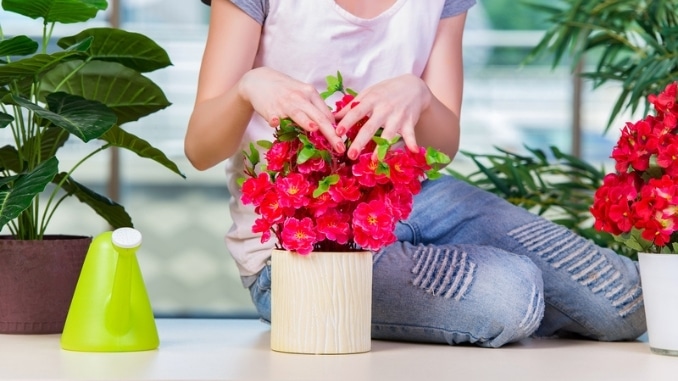
You may think the air in your home is safe, but according to research, that’s not always so.
The United States Environmental Protection Agency (EPA) states that Americans, on average, “spend 90 percent of their time indoors, where the concentration of some pollutants are often two to five times higher than typical outdoor concentrations.”
They add that energy-efficient construction on newer homes, which reduces air exchange, and the increased use of synthetic building materials have made the problem worse, say nothing of our heavy reliance on household cleaners, personal care products, and pesticides — all of which can contribute to indoor air pollution.
If you’ve ever experienced eye, nose or throat irritation, along with headaches, dizziness, fatigue and asthma attacks while in your home, you may have been the victim of pollution exposure. You can improve the air quality in a number of ways, by opening windows more often, frequent vacuuming with a high-efficiency particulate air (HEPA) filter, dusting regularly and leaving shoes at the door, but one of the most pleasant options is to install a few more houseplants.
Research shows that houseplants can help naturally filter out pollutants in your home. Some plants are better at it than others, and scientists are now experimenting with creating supercharged species that can remove even cancer-causing molecules like benzene and chloroform.
Dangerous Pollutants That Maybe in Your Home Right Now
Every day, we contribute to indoor air pollution in our homes. Cigarette smoking inside is the biggest offender, but there are many others. Wood and coal heating, cooking appliances and fireplaces can all release carbon monoxide and particulate matter.
Cleaning supplies can release volatile organic compounds (VOCs), and building materials may off-gas other polluting chemicals. Store-bought candles may release toxic compounds as do several household cleaners. Some types of furniture, particularly those that have been treated with fire retardants, also release chemicals linked to health problems.
In a recent study, researchers reported that after measuring fine particle counts for a week in living areas in San Diego, they found associations of higher weekly mean particle counts with reports of indoor smoking as well as with frying food, using candles or incense and house cleaning.
Typical indoor air pollutants that may have a negative effect on human health include:
- Radon: A radioactive element that percolates up through the earth itself and presents as an odorless, tasteless and invisible gas. Exposure is linked to cancer.
- VOCs: These are gases that get into the air from cleaning products, paints, glue, pesticides, home printers, hairspray, fabrics, and upholstery. Concentrations are consistently higher inside than outside. Exposure is linked to eye, nose and throat irritation; headaches; allergic skin reactions; nausea; fatigue and dizziness; damage to the central nervous system; and some cancers.
- Mold: Mold is a type of fungus that grows almost anywhere but can take hold in moist areas inside your home. It can produce allergens that cause allergic reactions and, sometimes, may release mycotoxins that can be toxic. Exposure is linked to asthma, sneezing, runny nose, red eyes, skin rash and nose, and throat irritation.
- Formaldehyde: This is a colorless gas that can be released from wood products ― plywood, particleboard and fiberboard ― paper products, insulation, glues, permanent press fabrics, paints and coatings, lacquers and finishes, paper products, fertilizers and pesticides, and some personal care products. Exposure is linked to irritation in the skin, eyes, nose, and throat. High levels are linked to some types of cancers.
- Tobacco: If someone in the home smokes, the home is likely polluted with compounds and chemicals from tobacco. Many of these are toxic and several are known carcinogens.
- Nitrogen oxide: Nitrogen oxide (NO) and nitrogen dioxide (NO2) are products of poor combustion that irritate the lungs, eyes, and mouth as well as trigger asthma attacks. They may be released by ovens, stoves, improperly installed appliances, kerosene heaters, welding, and tobacco smoke. High exposure is linked to lung disease and injury.
- Particulate matter: This is a mixture of solid and/or liquid particles suspended in the air. Those that are extremely small can be inhaled and, once inside the body, may affect the heart and lungs negatively. They can migrate indoors from outside, or they can be generated through the burning of candles; the use of fireplaces, unvented space heaters and kerosene heaters; cigarette smoking; and through the use of some hobby tools like glues and other chemicals.
- Carbon monoxide: This is an odorless, colorless, invisible gas that can kill humans. It’s a by-product of incomplete burning of fuels and is produced from cigarette smoke, automobile exhaust, leaking chimneys and furnaces, gas stoves, generators and other gasoline-powered equipment, back-drafting from wood stoves and fireplaces, kerosene heaters and worn and poorly adjusted boilers and furnaces. At low concentrations, it can cause fatigue, impaired vision, and reduced brain function. At higher concentrations, it can impair vision and coordination, cause headaches, dizziness, confusion, and nausea and even lead to death.
- Biologicals: These are pollutants from living organisms and include animal dander, cat saliva, dust mites, cockroaches, mold, bacteria or viruses, and pollen. They come from household pets; pollen-producing plants; and invading insects, bacteria, and viruses. Exposure is linked to sneezing and watery eyes, coughing, shortness of breath, lethargy, dizziness, some types of asthma and even digestive problems.
- Benzene: This is a VOC found in a variety of everyday products and chemicals in the home, including detergents, rubber, paint, dyes, ink, petroleum products, pharmaceuticals, gas-powered equipment, smoking and more. Exposure is linked to dermatitis, eye and throat irritation, headaches, dizziness, nausea and vomiting, and drowsiness. Long-term exposure can cause bone marrow damage and altered immune response.
How Houseplants Can Help Clean the Air in Your Home
In addition to cleaning regularly and ventilating your home, vacuuming and dusting often, testing for radon, installing a carbon monoxide detector and keeping paints, glues and other polluting items out of the house, one of the best ways to cut down on indoor air pollutants is to invest in certain houseplants.
In a 2009 study, researchers found that three houseplants — snake plants, spider plants, and golden pothos — all helped reduce ozone concentrations in an indoor environment. Earlier research from the National Aeronautics and Space Administration (NASA) showed that large-leafed plants with bare soil at the bottom were the best performers when it came to purifying the air.
Scientists explained in a 2011 study that through the natural process of photosynthesis, plants remove toxins from the air by metabolizing some of them and then releasing harmless by-products, and by incorporating those toxins into their tissues, thus trapping them.
In the NASA study, the golden pothos reduced air levels of benzene and trichloroethylene to barely detectable levels within two hours. Other research has found that some plants — particularly ferns — can reduce formaldehyde to safe levels while others can remove VOCs, and some — like Spanish moss — can even absorb mercury from the air.
Often, the soil is just as important as the plant itself as plants that have leaves that cover the soil didn’t do as well as improving air quality. In a 2004 study, researchers found that all seven plants studied helped remove benzene from the air but noted that micro-organisms in the potting soil were the main agents of removal.
Note that all of these studies were performed in simulated, laboratory conditions and we don’t yet have real-world studies testing plants in actual homes. It could be that the effects would not be as pronounced in a regular house since there is more ventilation present in a home than in a sealed laboratory room.
Still, considering these and other study results, you may feel compelled to have some houseplants in your home. The question is, which plants are best?
7 Good Options for Air-cleaning Houseplants
Though any plant may help clean the air, studies have shown that those with the following characteristics may work best:
- Those with large leaves — they have more surface area to trap pollutants
- Those that leave the soil in the pot exposed as the soil is instrumental in helping to trap some toxins
- Those that are easy to grow since the healthier the plant is, the better it will work
A good plan is to plant about two mature houseplants per 100 square feet of interior space. Choose from the following seven options.
1. Golden Pothos
This one was one of those used in the NASA studies, and it’s often recommended because it’s easy to grow. Some say it even refuses to die. It’s a fast-growing vine and is best left to cascade down from a hanging basket. Also known as devil’s ivy, it needs bright, indirect light and a well-draining potting mix.
2. Spider Plant
This plant belongs to the lily family and has long, narrow leaves. It’s considered extremely durable and also works best as a hanging plant as its leaves tend to fan out in arching displays. Also called the “airplane” plant, it prefers bright light by a window but will do fine in lower light conditions. Any good potting soil will do as long as it drains well.
3. Peace Lily
Although not a member of the lily family, this plant’s flowers resemble those of the calla lily — thus, its name. It works best as a floor plant as it can grow up to three feet tall and has wide, big leaves for cleaning the air. If you have cats, however, skip this one as it contains oxalates that can irritate an animal’s mouth and stomach. It’s also toxic to dogs if ingested. It likes partial shade and well-draining all-purpose soil.
4. Bamboo Palm
Happiest near partial light, the bamboo palm can grow from five to seven feet and brings tropical flair to any space. With feathery dark green leaflets, it has stems covered in a tan-colored fiber that resembles bamboo. It’s a rugged plant that’s not killed easily and likes well-drained soils.
5. Dracaena Janet Craig
With large, thick leaves, this plant is native to tropical Africa and is one of the most popular indoor plants. It grows well in low light and needs little water. It can be used as a table plant, floor plant or even a tall tree. Described as virtually indestructible. Needs loose soil that drains quickly.
6. Boston Fern
This is a type of sword fern that has distinctive arching fronds and likes indirect light and cooler temperatures, around 55 to 65 degrees Fahrenheit. It also likes humid air and does well near a steamy bathroom or on a water-filled pebble tray. If you have a humidifier in one room, place your fern there or mist the leaves a couple of times a week. It works well as a hanging plant so that the leaves can cascade out, but it can work as a floor plant too.
7. Weeping Fig
Native to India and Southeast Asia, this plant works well in the corner or as a large indoor tree for an entryway. It has large, arching branches and long, pointed leaves. It likes a bright room, fast-draining soil, and moist soil. It doesn’t like being moved around, so find it a spot and let it make a home there.
Our environment has an enormous impact on our health. So does the food we eat. For you guide to the best foods to heal your body, check out The Best Foods that Rapidly Slim & Heal in 7 Days, here!




